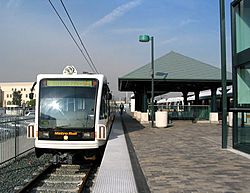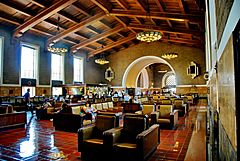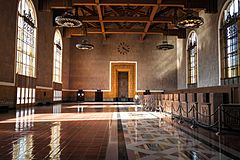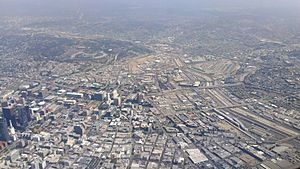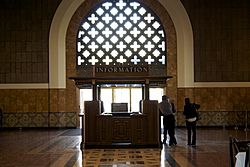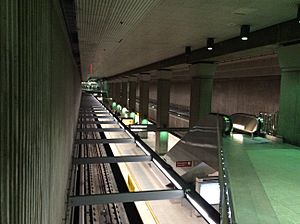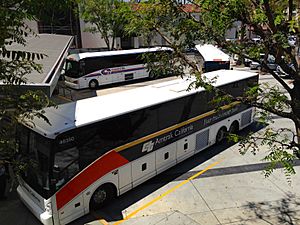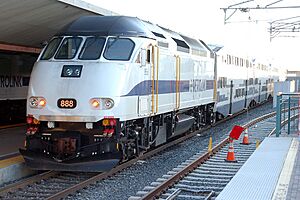Union Station (Los Angeles) facts for kids
Quick facts for kids
Los Angeles Union Station
|
|||||||||||||||||||||||||||||||||||||||||||||||||||||||||||||||||||||||||||||||||||||||||||||||
|---|---|---|---|---|---|---|---|---|---|---|---|---|---|---|---|---|---|---|---|---|---|---|---|---|---|---|---|---|---|---|---|---|---|---|---|---|---|---|---|---|---|---|---|---|---|---|---|---|---|---|---|---|---|---|---|---|---|---|---|---|---|---|---|---|---|---|---|---|---|---|---|---|---|---|---|---|---|---|---|---|---|---|---|---|---|---|---|---|---|---|---|---|---|---|---|
| Amtrak, Metrolink and LA Metro station | |||||||||||||||||||||||||||||||||||||||||||||||||||||||||||||||||||||||||||||||||||||||||||||||
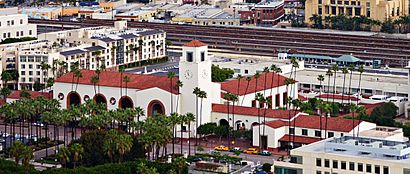
Main building and tracks
|
|||||||||||||||||||||||||||||||||||||||||||||||||||||||||||||||||||||||||||||||||||||||||||||||
| Location | Amtrak/Metrolink 800 North Alameda Street Metro 801 Vignes Street Los Angeles, California 90012 United States |
||||||||||||||||||||||||||||||||||||||||||||||||||||||||||||||||||||||||||||||||||||||||||||||
| Coordinates | 34°03′19″N 118°14′07″W / 34.05515°N 118.23525°W | ||||||||||||||||||||||||||||||||||||||||||||||||||||||||||||||||||||||||||||||||||||||||||||||
| Owned by | Los Angeles County Metropolitan Transportation Authority | ||||||||||||||||||||||||||||||||||||||||||||||||||||||||||||||||||||||||||||||||||||||||||||||
| Platforms | 6 island platforms (Amtrak/Metrolink) 1 island platform (Metro L Line) 1 island platform (Metro B/D Lines) 1 island platform (Metro J Line) |
||||||||||||||||||||||||||||||||||||||||||||||||||||||||||||||||||||||||||||||||||||||||||||||
| Tracks | 12 (Amtrak/Metrolink) 2 (Metro L Line) 2 (Metro B/D Lines) |
||||||||||||||||||||||||||||||||||||||||||||||||||||||||||||||||||||||||||||||||||||||||||||||
| Construction | |||||||||||||||||||||||||||||||||||||||||||||||||||||||||||||||||||||||||||||||||||||||||||||||
| Parking | 3,000 spaces | ||||||||||||||||||||||||||||||||||||||||||||||||||||||||||||||||||||||||||||||||||||||||||||||
| Bicycle facilities | 74 bike rack spaces 20 locker spaces |
||||||||||||||||||||||||||||||||||||||||||||||||||||||||||||||||||||||||||||||||||||||||||||||
| Disabled access | Yes | ||||||||||||||||||||||||||||||||||||||||||||||||||||||||||||||||||||||||||||||||||||||||||||||
| Other information | |||||||||||||||||||||||||||||||||||||||||||||||||||||||||||||||||||||||||||||||||||||||||||||||
| Station code | Amtrak code: LAX | ||||||||||||||||||||||||||||||||||||||||||||||||||||||||||||||||||||||||||||||||||||||||||||||
| Website | UnionStationLA.com | ||||||||||||||||||||||||||||||||||||||||||||||||||||||||||||||||||||||||||||||||||||||||||||||
| History | |||||||||||||||||||||||||||||||||||||||||||||||||||||||||||||||||||||||||||||||||||||||||||||||
| Opened | May 3, 1939 | ||||||||||||||||||||||||||||||||||||||||||||||||||||||||||||||||||||||||||||||||||||||||||||||
| Traffic | |||||||||||||||||||||||||||||||||||||||||||||||||||||||||||||||||||||||||||||||||||||||||||||||
| Passengers (2018) | 1,717,405 |
||||||||||||||||||||||||||||||||||||||||||||||||||||||||||||||||||||||||||||||||||||||||||||||
| Rank | 1st in California | ||||||||||||||||||||||||||||||||||||||||||||||||||||||||||||||||||||||||||||||||||||||||||||||
|
|||||||||||||||||||||||||||||||||||||||||||||||||||||||||||||||||||||||||||||||||||||||||||||||
|
|||||||||||||||||||||||||||||||||||||||||||||||||||||||||||||||||||||||||||||||||||||||||||||||
|
Los Angeles Union Passenger Terminal
|
|||||||||||||||||||||||||||||||||||||||||||||||||||||||||||||||||||||||||||||||||||||||||||||||
| Built | 1939 | ||||||||||||||||||||||||||||||||||||||||||||||||||||||||||||||||||||||||||||||||||||||||||||||
| Built by | Robert E. McKee Inc. | ||||||||||||||||||||||||||||||||||||||||||||||||||||||||||||||||||||||||||||||||||||||||||||||
| Architect | Parkinson, John & Donald B. | ||||||||||||||||||||||||||||||||||||||||||||||||||||||||||||||||||||||||||||||||||||||||||||||
| Architectural style | Moderne, Art Deco, Mission/Spanish Revival | ||||||||||||||||||||||||||||||||||||||||||||||||||||||||||||||||||||||||||||||||||||||||||||||
| NRHP reference No. | 80000811 | ||||||||||||||||||||||||||||||||||||||||||||||||||||||||||||||||||||||||||||||||||||||||||||||
| Significant dates | |||||||||||||||||||||||||||||||||||||||||||||||||||||||||||||||||||||||||||||||||||||||||||||||
| Added to NRHP | November 13, 1980 | ||||||||||||||||||||||||||||||||||||||||||||||||||||||||||||||||||||||||||||||||||||||||||||||
Los Angeles Union Station (LAUS) is the main train hub in Los Angeles, California. It is the largest passenger train station in the Western United States. The station opened in May 1939. It was first called the Los Angeles Union Passenger Terminal. It replaced two older stations: La Grande Station and Central Station.
In the 1930s, this station brought together train services from three big railroad companies. These were the Union Pacific, Santa Fe, and Southern Pacific Railroads. Union Station is known as the "Last of the Great Railway Stations" built in the United States. Its design mixes Art Deco, Mission Revival, and Streamline Moderne styles. It was added to the National Register of Historic Places in 1980.
Today, Union Station is a very important travel center for Southern California. About 110,000 passengers use it every day. It is the busiest train station in the Western United States. It is also one of the busiest train stations in the whole country.
Four of Amtrak's long-distance trains start and end here. These include the Coast Starlight to Seattle and the Southwest Chief to Chicago. The Sunset Limited goes to New Orleans, and the Texas Eagle also goes to Chicago. The Pacific Surfliner regional trains run often to San Diego, Santa Barbara, and San Luis Obispo. The station is also the main hub for the Metrolink commuter train system. It is a key spot to switch between different Metro Rail subway and light rail lines. The Patsaouras Transit Plaza on the east side of the station serves many bus lines. These are run by Metro and other city bus companies.
Contents
- Discovering Union Station's History
- The Amazing Architecture of Union Station
- Art and Beauty at Union Station
- Where is Union Station Located?
- Trains and Buses at Union Station
- Future Plans for Union Station
- See also
Discovering Union Station's History
In 1926, people in Los Angeles voted on a big decision. They had to choose between building many elevated railways or one large Union station. This new station would combine the city's two main train stations. One idea for Union Station was to build it in the middle of the original Chinatown.
The Los Angeles Times newspaper was against elevated railways. They wrote that Union Station would "forever do away with Chinatown." This shows some of the unfair feelings of that time. The newspaper also said elevated railways would block the California sun.
Voters approved Union Station by a large margin. They also chose the Los Angeles Plaza area for the station. However, because of efforts by people like Christine Sterling, the station was built across the street in Chinatown. This area was taken down for the project. During construction, old items from the Tongva village of Yaanga were found. This village was once located there.

The new station cost $11 million in 1939. It replaced La Grande Station, which was damaged in the 1933 Long Beach earthquake. It also replaced Central Station.
Train services were provided by the Santa Fe, Southern Pacific, and Union Pacific. Local lines like the Pacific Electric Railway also used it. Famous trains like the Super Chief carried Hollywood stars to Chicago. Union Station was very busy during World War II. But later, fewer people used trains because cars and planes became popular.
In 1948, the Santa Fe's Super Chief train had a problem. It crashed through a wall at the station. No one was hurt, but the engineer lost his job.
The station was named a Los Angeles Historic–Cultural Monument in 1972. It was added to the National Register of Historic Places in 1980.
The first commuter train service to Union Station started in 1982. It was called CalTrain. This service was stopped in 1983. Another commuter train, the Orange County Commuter, began in 1990.
In the early 1990s, Metrolink commuter rail service began. Union Station became the main stop for several Metrolink lines. In 1993, Metro's Red Line subway started service to the station. The Orange County Commuter train was replaced by Metrolink's Orange County Line in 1994.
Light Rail service came to Union Station in 2003. The Metro L Line began running from tracks 1 and 2. This line was later extended.
In 2011, the Los Angeles County Metropolitan Transportation Authority (Metro) bought Union Station for $75 million. Since then, Metro has added more services for passengers. They have also brought in new shops and restaurants.
Amtrak opened a special lounge for passengers in 2013. It is called the Metropolitan Lounge. It offers free snacks, Wi-Fi, and priority boarding. Metro also plans to use Bluetooth to send text messages to travelers' smartphones.
The Amazing Architecture of Union Station
Union Station was partly designed by John and Donald Parkinson. This father-and-son team also designed Los Angeles City Hall. Other architects helped, including Jan van der Linden. The building combines Art Deco, Mission Revival, and Streamline Moderne styles. It has special details like eight-pointed stars.
There are garden patios on both sides of the waiting room. The lower parts of the inside walls are covered in travertine marble. The upper parts have special sound-absorbing tiles. The floor in the big rooms is made of terra cotta with marble designs. The ceiling in the main waiting room looks like wood but is actually steel. The original ticket lobby has very high ceilings. It is usually closed but is sometimes used for movies or events.
The Traxx restaurant and bar is inside the main waiting room. It has an Art Deco style that matches the station's history. It is a popular spot at Union Station.
Next to the main building is the station restaurant. It was designed by the famous architect Mary Colter. This was the last "Harvey House" restaurant built in a train station. The large dining room has a round counter and special floor tiles. These tiles look like a Navajo blanket. Colter also designed a cool, Streamline Moderne cocktail lounge. The restaurant closed in 1967. In 2018, after a big renovation, it reopened as the "Imperial Western Beer Co." The cocktail lounge reopened as "The Streamliner."
Even though Union Station is very grand, it is considered small compared to other union stations.
Art and Beauty at Union Station
Union Station did not have many sculptures or artworks when it first opened. But when Metro rail was built in the 1990s, many new art pieces were added. These include murals, stone seating, electronic art, and glass mosaics. There is also a river-themed art piece with old objects found during subway digging. It even has an aquarium with local sea life.
Some of the public artworks at Union Station include:
- L.A.: City of Angels (1993) by Cynthia Carlson
- Traveler (1993) by Terry Schoonhoven
- Union Chairs (1993) by Christopher Sproat
- La Sombra del Arroyo (1995) by East Los Streetscapers
- City of Dreams (1996) by Richard Wyatt Jr.
- River of History (1996) by May Sun
- Riverbench (1996) by May Sun and Paul Diez
- A-Train (1996) by Bill Bell
- Solar Shift: San Bernardino and Santa Monica (2006) by Roy Nicholson
Where is Union Station Located?
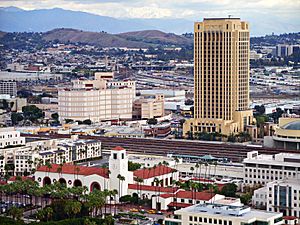
Union Station is in the northeast part of Downtown Los Angeles. It is bordered by Alameda Street, Cesar Chavez Avenue, Vignes Street, and the Hollywood Freeway. It is across Alameda Street from historic Olvera Street and El Pueblo de Los Angeles State Historic Park. The old Terminal Annex building is nearby. Chinatown and Civic Center are also close.
The area was once home to the Tongva village of Yaanga. This was thought to be the largest Tongva village.
The Patsaouras Transit Plaza is on the east side of Union Station. Many bus lines use this plaza. These include Metro Local, Metro Rapid, and Metro Express lines. There are also DASH shuttles, city bus lines, and FlyAway express buses to Los Angeles International Airport. University of Southern California campus shuttles also stop here. The plaza is named after Nick Patsaouras, who supported public transportation.
The Gateway Transit Center includes the station and the Patsaouras Transit Plaza. It also has the end of the El Monte Busway and Metro's main office building.
As of October 2019, Amtrak and Metrolink share 12 of Union Station's 14 outdoor tracks. About 94 trains leave on most weekdays.
Trains and Buses at Union Station
Amtrak Services
Union Station is the starting and ending point for four of Amtrak's long-distance trains:
- Coast Starlight: Travels to Seattle every day.
- Southwest Chief: Travels to Chicago every day.
- Sunset Limited: Travels to New Orleans three times a week.
- Texas Eagle: Travels to Chicago three times a week. This train combines with the Sunset Limited for part of its journey.
Amtrak California Regional Trains
Amtrak California runs regional train services many times a day to cities across the state:
- Pacific Surfliner: Runs from San Diego to San Luis Obispo through Los Angeles. Most of these 13 daily trips start and end here.
- You can connect to the San Joaquin trains to Oakland or Sacramento using Amtrak Thruway Motorcoach buses.
Metrolink Commuter Trains
The station is the main hub for Metrolink. Six of Metrolink's seven lines serve Union Station:
- Antelope Valley Line: To Lancaster.
- Riverside Line: To Riverside.
- Orange County Line: To Oceanside.
- San Bernardino Line: To San Bernardino.
- Ventura County Line: To Ventura.
- 91/Perris Valley Line: To Perris.
Metro Rail Subway and Light Rail
Three Metro Rail lines serve Union Station. These are the B (Red), D (Purple), and L (Gold) Lines. About 300 Metro Rail trains leave every weekday.
Metro B Line and Metro D Line
The Metro B and Metro D subway lines end at Union Station. They share two tracks underground. You can enter the platform from inside Union Station's main area or near the Patsaouras Transit Plaza.
Metro L Line
The Metro L Line (Gold) is a light rail line. It goes through Union Station on its way between Azusa and East Los Angeles. These trains use Tracks 1 and 2. You can reach the platform by stairs and elevator. The platform has an art piece called Images of Commonality/Nature and Movement.
This platform will also be used by the A Line in the future.
Metro Busway Services
Metro J Line
One Metro Busway line stops at the Patsaouras Transit Plaza. The Metro J Line is a bus rapid transit line. It runs between El Monte Bus Station, Downtown Los Angeles, Harbor Gateway Transit Center, and some trips go to San Pedro.
Bus and Coach Connections
Long-Distance Buses
Amtrak Thruway Motorcoach
Amtrak California runs several bus routes from Union Station. These buses connect to Amtrak trains.
- Route 1A: Bakersfield – Los Angeles
- Route 1B: Bakersfield – Los Angeles – San Pedro (for cruise terminals)
When trains are not running at night, buses provide service along the Pacific Surfliner and San Joaquin routes. Amtrak also has a bus route to Las Vegas from Union Station.
Flixbus and Megabus
Flixbus offers intercity bus service to places across the Western United States. It stops near the station. Megabus also runs long-distance bus routes from the Patsaouras Transit Plaza. These include routes to Las Vegas and San Francisco.
Local Metro and City Buses
Many local and city bus services use the Patsaouras Transit Plaza. These include Metro Local, Metro Rapid, and LADOT Commuter Express buses. The LAX FlyAway bus to the airport also stops here.
Other bus services stop on Cesar Chavez Avenue & Vignes Street, and Alameda Street & Los Angeles Street. The Dodger Stadium Express bus runs from the west side of the station during baseball season.
Future Plans for Union Station
New Bus Station on El Monte Busway
A new bus station for the Metro J Line and other buses is being built. It will be located south of the Patsaouras Transit Plaza. This new station will help buses serve Union Station faster.
The station was planned to open earlier but faced delays. These delays included finding old human remains from a Tongva settlement. The station officially opened on November 1, 2020.
Link Union Station Project
Union Station's current track layout makes it hard for many trains to use it. Trains can only enter or leave from the north side. This means trains sometimes have to wait outside the station.
Metro has proposed the Link Union Station project to fix this. This project will extend some tracks so trains can go straight through the station. These new tracks will cross over US Route 101 on a raised "S-curve." The plan also includes tracks that will create a "loop" around the station. This will allow all trains to use the new run-through tracks.
This project will increase the station's track capacity by 40%. The Metro board approved the environmental studies for this project in 2019. They also approved a funding plan in 2020. The project is expected to be finished by 2026.
California High-Speed Rail
Union Station is planned to be a major hub for the future California High-Speed Rail System. Once it's built, passengers should be able to travel from Union Station to San Francisco in about 2 hours and 40 minutes.
Metro is studying how to add tracks and platforms for high-speed trains. They are looking at options like building above or below the current platforms. All plans include a new area for high-speed rail passengers and three platforms with six tracks.
See also
 In Spanish: Union Station (Los Ángeles) para niños
In Spanish: Union Station (Los Ángeles) para niños


